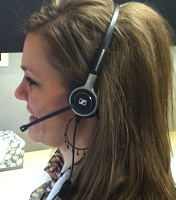There were 2 posts tagged: Microphone Placement
Hello? Hello? Hello? Hello? (Does Your Headset Have an Echo?)
Congratulations on your purchase of a brand new headset! You’ve connected it to your phone, started to make calls with it … and the person on the other end  of the call tells you that you sound like you’re in a cave. A pesky echo is destroying the quality of your calls. You wonder if you’ve made a bad purchasing decision and consider going back to using your phone’s handset. Don’t despair: we’re here to help!
of the call tells you that you sound like you’re in a cave. A pesky echo is destroying the quality of your calls. You wonder if you’ve made a bad purchasing decision and consider going back to using your phone’s handset. Don’t despair: we’re here to help!
Also, don’t forget the importance of proper microphone positioning. This too can be the cause of a subpar sound experience.
To find out how and where to adjust the mic volume of your particular headset, you can refer to the headset user manual or better yet, just pick up the phone and give us a call. We love to hear from our customers and are always happy to help! You can reach our support staff at 1-866-998-9991.
This is an easy fix to a common (and annoying) problem!
 of the call tells you that you sound like you’re in a cave. A pesky echo is destroying the quality of your calls. You wonder if you’ve made a bad purchasing decision and consider going back to using your phone’s handset. Don’t despair: we’re here to help!
of the call tells you that you sound like you’re in a cave. A pesky echo is destroying the quality of your calls. You wonder if you’ve made a bad purchasing decision and consider going back to using your phone’s handset. Don’t despair: we’re here to help!The Echo Fix
If you or your customers are hearing an echo, the mic volume may be set too high. Jabra says that the audio level of your headset microphone should approximately match the audio level of your desk phone. Make a test call, and while you are talking, decrease the mic volume one step at a time. It’s important that your mic level be high enough so that your customers can hear you well, but it shouldn’t be so high that you are hearing yourself echo back through the headset. Another indication that your mic level is too high is if you hear your breath or excessive wind-type noise through your headset.Also, don’t forget the importance of proper microphone positioning. This too can be the cause of a subpar sound experience.
To find out how and where to adjust the mic volume of your particular headset, you can refer to the headset user manual or better yet, just pick up the phone and give us a call. We love to hear from our customers and are always happy to help! You can reach our support staff at 1-866-998-9991.
This is an easy fix to a common (and annoying) problem!
Headset Microphones: Positioning the Microphone Part 2 of 2
In our previous post, we shared the three main types of microphones found in office and contact center headsets: see Part 1 here. The type of microphone you choose depends on your work environment and job requirements. Another important element in audio quality is the placement of the microphone to assure that your voice is heard loud and clear.
According to Plantronics, the single biggest real-world cause of poor transmit audio is not technical; rather, it is poor microphone placement by the user. As microphones offer higher degrees of noise cancelling, they demand greater proximity and consistency of microphone placement so that the talker does not become part of the very background that is being cancelled.
Proper microphone placement is particularly important in directional microphones with noise-cancelling properties. These microphones reject background noise and bring the user's voice to the foreground. The microphone boom should be adjusted so that it is 2 finger widths from your bottom lip.
 1. Flex boom models have flexible booms that are easy to bend and can be reshaped until they are near the user's mouth. Here, the Jabra PRO 9450 Mono Headset with Flex Boom is pictured.
1. Flex boom models have flexible booms that are easy to bend and can be reshaped until they are near the user's mouth. Here, the Jabra PRO 9450 Mono Headset with Flex Boom is pictured.
2. Fixed boom arm models rotate from the receiver, and should not be bent. The boom arm should point directly at the user's mouth. Pictured here is Sennheiser's SC 660 USB CTRL Century Series Ultra Noise Cancelling Duo USB Headset with In-Line Call Controls.
 Jabra reminds new headset users that they won't need to talk as loudly as when speaking into a handheld phone. When the microphone has been positioned correctly close to the mouth, your voice will be picked up clearly – even at a lower volume.
Jabra reminds new headset users that they won't need to talk as loudly as when speaking into a handheld phone. When the microphone has been positioned correctly close to the mouth, your voice will be picked up clearly – even at a lower volume.
Headsets help you to communicate clearly and effectively. Research the right microphone for the work you do, and purchase a high quality commercial headset that meets your requirements. Take that extra step of assuring correct placement of that microphone with a simple adjustment and your caller will thank you!
For more information about the proper care of your headset, and correct microphone positioning, Jabra offers this handy one-page document.
According to Plantronics, the single biggest real-world cause of poor transmit audio is not technical; rather, it is poor microphone placement by the user. As microphones offer higher degrees of noise cancelling, they demand greater proximity and consistency of microphone placement so that the talker does not become part of the very background that is being cancelled.
Proper microphone placement is particularly important in directional microphones with noise-cancelling properties. These microphones reject background noise and bring the user's voice to the foreground. The microphone boom should be adjusted so that it is 2 finger widths from your bottom lip.
 1. Flex boom models have flexible booms that are easy to bend and can be reshaped until they are near the user's mouth. Here, the Jabra PRO 9450 Mono Headset with Flex Boom is pictured.
1. Flex boom models have flexible booms that are easy to bend and can be reshaped until they are near the user's mouth. Here, the Jabra PRO 9450 Mono Headset with Flex Boom is pictured. 2. Fixed boom arm models rotate from the receiver, and should not be bent. The boom arm should point directly at the user's mouth. Pictured here is Sennheiser's SC 660 USB CTRL Century Series Ultra Noise Cancelling Duo USB Headset with In-Line Call Controls.
 Jabra reminds new headset users that they won't need to talk as loudly as when speaking into a handheld phone. When the microphone has been positioned correctly close to the mouth, your voice will be picked up clearly – even at a lower volume.
Jabra reminds new headset users that they won't need to talk as loudly as when speaking into a handheld phone. When the microphone has been positioned correctly close to the mouth, your voice will be picked up clearly – even at a lower volume.Headsets help you to communicate clearly and effectively. Research the right microphone for the work you do, and purchase a high quality commercial headset that meets your requirements. Take that extra step of assuring correct placement of that microphone with a simple adjustment and your caller will thank you!
For more information about the proper care of your headset, and correct microphone positioning, Jabra offers this handy one-page document.

